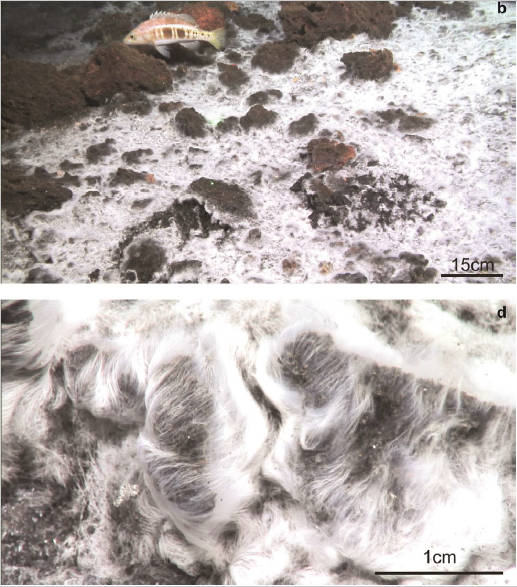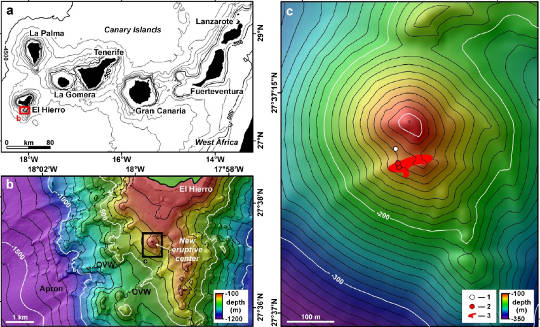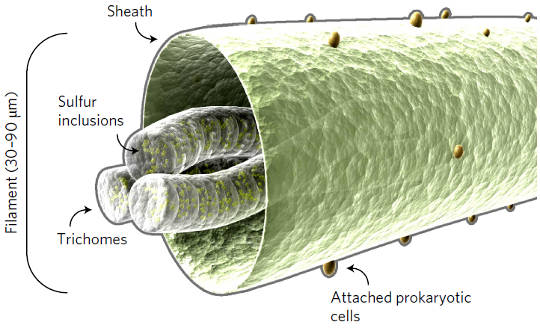This article was published in Scientific American’s former blog network and reflects the views of the author, not necessarily those of Scientific American

Venus's hair is white. Yours would be too if you had to deal with everything the ocean does. Supplementary Fig. 2 b and d. Credit: Danovaro et al. 2017
Half an acre of hair: that’s what a group of startled scientists discovered growing on the flanks of the undersea volcano Tagoro in 2014, just under three years after its last eruption. Despite decades of searching undersea vents and volcanoes, nothing like it had ever been seen before.

Location of Tagoro Volcano in the Canary Islands, and the position of the Venus's hair on the volcano (red blob, c). Circles 1 and 2 are the location of sample sites. Supplementary Figure 1. Credit: Danovaro et al. 2017
On supporting science journalism
If you're enjoying this article, consider supporting our award-winning journalism by subscribing. By purchasing a subscription you are helping to ensure the future of impactful stories about the discoveries and ideas shaping our world today.
This unusual find may be due to a quirk of the volcano’s geography. The vent is located in the Canary Islands in the northeast Atlantic Ocean. Unlike the volcanoes which occur in long chains along tectonic plate boundaries (the Mid-Atlantic Ridge, for example), this one is isolated from other volcanoes or hydrothermal vents with established communities of organisms that could quickly colonize new rock. One of the only other comparable places is the undersea volcano Lo’ihi, currently scheduled to become the next island in the Hawaiian chain sometime between 10,000 and 100,000 years from now (if it continues growing at the present rate – or at all; as Hawaiians have noted, volcanoes are fickle).
Whatever the cause, the new community – dubbed Venus’s hair by the scientists -- is undoubtedly unique. Not only are the bacteria that build this hair clearly a new species (their DNA is so different from their closest relatives that they are also in a new genus), their structure is unusual too.
The story begins in October of 2011, with Tagoro coughed to life for the first of 138 days. In that time, is spewed enough lava to cover nine square kilometers of the sea floor and raised a cone 274 meters (900 feet) above the previous seabed, to within 89 meters (300 feet) of the surface. The volcano also released lava “balloons”. Apparently, when magma is thin and effervescent, pieces can bleb off and float to the surface to become lava life preservers with a hot bubbly nougat center. There, they occasionally explode. You can see a picture of some from this eruption here.
Along with all the lava, the volcano released lots of carbon dioxide and hydrogen sulfide. At the same time, the oxygen concentration of the water plummeted, a suffocating combination that killed many animals in the area.
Fast forward 32 months. An ROV drops to the sea floor, operated by a team of Italian, British, and Spanish scientists (who published their results in Nature Ecology and Evolution last month). To their surprise, the area of greatest devastation has been colonized by a carpet of white filaments up to three centimeters long.
They must have been further surprised they placed strands of Venus’s hair under the microscope. The filaments were like fiber optic cables.

Light micrograph of a single Thiolava veneris filament plucked from solid lava and visualized at 10x. Credit: Roberto Danovaro
Several long chains of bacteria called “trichomes” lay inside a gelatinous sheath (trichomes, by the way, is the same term used to describe the microscopic hairs that cover plants). Clinging to the exterior of the sheath like barnacles were much smaller bacteria of different species.

Credit: Danovaro et al. 2017
These trichomes had a diameter of three to six micrometers -- somewhat large for bacteria. The sheath surrounding them is 36 to 90 micrometers wide. The sheath may help to deter grazing by microbes or animals attracted to a mass bacterial bloom.
The trichome-forming bacteria are similar to another bacterium called Thioploca. It, too, forms a bundle of trichomes surrounded by a mucus sheath. Rather than anchoring themselves to rock, they live in sediment on the sea bed and use their sheath to shuttle back and forth between the water, where the nitrate they need to grow is, and the sediment, where they harvest sulfide.
Venus's hair, newly dubbed Thiolavaveneris, can get both of those molecules from the water around the volcano – if it can manage to stay in place. Gluing oneself to the seabed is one way of accomplishing this.
DNA comparisons also showed that the organisms living in Venus’s Hair are unlike any organisms found anywhere else – hydrothermal vents or otherwise -- in the ocean to date. They don’t just look different. They are different.
Inside Thiolava is a high concentration of elemental sulfur dissolved in the cytosol -- the soup base of the cell. Unlike Thioploca and a related genus called Beggiatoa, it was not contained in a containment sac called a vacuole. The bacteria appear to be missing an enzyme whose presence would require the sulfur to be packaged; without it, they’re free to just dump sulfur anywhere they like. So they do.
The DNA sequences of these bacteria also seem to indicate that Thiolava can both eat organic chemicals emitted by volcanic gasses and make its own food from inorganic volcanic chemicals -- just like the bacteria inside the giant shipworm I wrote about here last time. And, somewhat bizarrely, it has three different biochemical pathways for accomplishing this. However, it lacks genes for photosynthesis, the process in which plants and algae use sunlight to turn carbon dioxide into food. It also appears to contain genes to improve its tolerance of metals that might be part of the volcanic gasses. Taken together, Thiolava certainly seems to possess a unique suite of biochemical pathways.
This bacterial shag carpet also proved a welcoming home to a variety of other bacteria (although strangely, virtually no archaea), protists, and animals. The combination of bacteria found living in and on the mat was radically different from any seen before – even from the bacteria in the seawater floating around it. All sorts of animals found in sediment and hydrothermal vents lived in the mat as well, including arthropods, annelid wormsLINK, nematodeLINK worms (roundworms), and the larval and juvenile stages of the animals that live in the water just above the seafloor. Thiolava is edible, apparently, or at least a hip place to hang out.
Intriguingly, although the animals found in the mat were all from recognizable groups, they were not from recognizable species. Most of the animals that live in Venus’s Hair are just as unknown to science as the hair itself was until recently.
How did such a major community of organisms escape our notice so long? That’s easy. It’s located on the bottom of the ocean, a place we still know far less about than the surface of Mars.
Reference
Danovaro, Roberto, Miquel Canals, Michael Tangherlini, Antonio Dell’Anno, Cristina Gambi, Galderic Lastras, David Amblas et al. "A submarine volcanic eruption leads to a novel microbial habitat." Nature Ecology & Evolution 1 (2017): 0144.